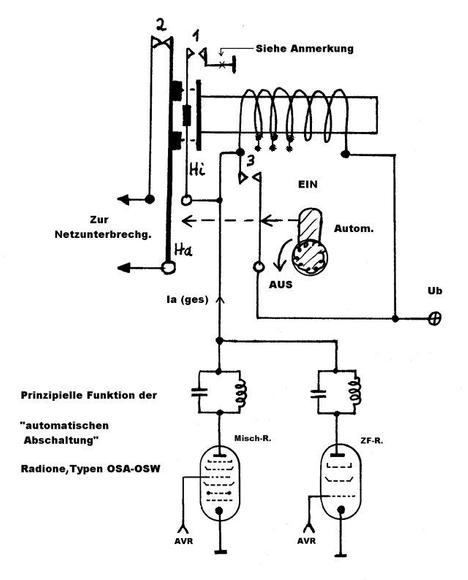radione: Switch-off Relay
ID: 232598
This article refers to the model: OSW/R (Radione (RADIO Nikolaus Eltz); Wien)
radione: Switch-off Relay
09.Oct.10 17:57
2125


Automatic Switch-off ‚RADIONE‘
The types OSA (all current) and OSW (alternate current) were, on request, available with an “Automatic Switch-off” feature. A special relay will cut off the mains after the carrier wave is shut down at the end of the daily broadcast.
Because I own the OSA, a functional description may be of some help.
Because I own the OSA, a functional description may be of some help.
1. First make sure, the handle for the Automatic is in the ‘AUS’ position before the radio is switched on. Contact 3 shortens the relay coil. The mains is fed-through via contact 2.
2. After warming up, the Switch-off Automatic may be activated. The mentioned handle is to be turned in the upright position which opens contact 3 and the common anode current of the mixer and if stage flows through the relay coil. (Indicated position).
3. Normally, the dial is tuned to a favorite station near-by. The voltage produced by the Automatic Volume Control (AVR) is too negative, not strong enough (< 6 mA) to activate the relay.
4. After the end of transmission at midnight, the carrier wave disappears. The AVR decreases and the current through the relay coil will increase above 6 mA.
5. This causes the small auxiliary member Hi to move jerky, because it is withheld by some magnetic force. Contact 1 is now closed, allowing maximum current flow through the relay coil.
6. As a result of this, the main member Ha is activated too, which mechanically bolts itself!
We see contact 2 open, the mains supply (Netz) is interrupted and the radio is switched-off.
7. As the high voltage (Ub) slowly disappears, the small member Hi returns to the start position which opens contact 1 again.
8. To switch-on the radio in the morning, first one has to turn the handle at the rear side (!) to the left (Automatik = Aus) in order to release the self-bolting of the relay. This will close contact 2 and the whole procedure will start again. See point 1.
I’m asking myself, is this laborious procedure of any advantage having regard to the cumbersome handling of this “Automatic Switch-off” thing?
Note
Under certain circumstances (the radio station disappears and at the same time the handle at the rear is turned to the off position), the for a while present high voltage (Ub) is shortened to ground via contact 3 and 1!
To prevent damage at the mentioned contacts, an additional resistor of 5.6 kOhm was added by me at point X, reducing the discharge current, without having negative influence of the overall function.
Wolfgang Holtmann
To thank the Author because you find the post helpful or well done.